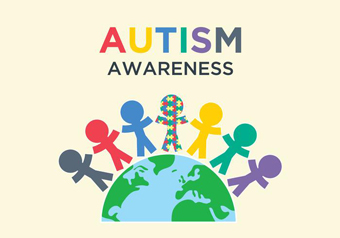World Autism Awareness Day
World Autism Awareness Day
 World Autism Awareness Day is an internationally recognised day which is celebrated on 02 April every year. The day is used for encouraging the member states of the United Nations to adopt measures to create awareness of people with Autism around the world. The day is used to bring individual organisations together to aid in research, diagnosis, treatment and overall acceptance of this developmental disorder.
World Autism Awareness Day is an internationally recognised day which is celebrated on 02 April every year. The day is used for encouraging the member states of the United Nations to adopt measures to create awareness of people with Autism around the world. The day is used to bring individual organisations together to aid in research, diagnosis, treatment and overall acceptance of this developmental disorder.The observance of World Autism Awareness Day 2019 is on ‘Assistive Technologies, Active Participation’, wherein the states will focus on leveraging the use of assistive technologies for autistic people as a tool for removing the barriers that exist in the social, political and economic spheres to promote equality, equity and inclusion.
What is autism?
It is a broad range of conditions that are characterised by challenges with social skills, repetitive behaviours, verbal and non-verbal communication. Autism actually exists is various sub-categories which are mostly influenced by a combination of genetic and environmental factors. Autism is also known as ‘spectrum disorder’ because there is a wide variation in the type and severity of the symptoms that people experience.
Autism mostly occurs more in boys than girls with 4:1 male-to-female ratio. Autism or Autism Spectrum Disorder occurs across all ethnic, racial and economic groups to pose a challenge to a person’s symptoms and ability to function.
Myths of autism
Though there are several researches that are based on autism which have come out in recent times to raise sensitivity against autistic people, there are also several misconceptions that have been made about them. Here are some of the myths that exist around autism-
-
People with autism do not want friends
-
Autistic people are intellectually disabled
-
Autism is just a brain disorder
-
Autism is caused due to ‘bad parenting’
-
Autism only affects children
Causes of Autism
The exact cause of an Autism Syndrome Disorder or ASD remains unknown. Current research and studies show that there exists not one, but several causes to autism. Some of the suspected risk factors for autism include-
-
Having an immediate family member with autism
-
Genetic mutations
-
Lower birth weight
-
Exposure environmental toxins
-
Imbalances in hormones
-
Being born to older parents
How to handle Autistic children?
While there may be several ways by which you can take care of children with autism, it is also equally important that one also takes care of himself or herself. Being in emotionally strong is one of the strongest tips that needs to be given to people who handle autistic children on a regular basis.
While there may be several ways by which you can take care of children with autism, it is also equally important that one also takes care of himself or herself. Being in emotionally strong is one of the strongest tips that needs to be given to people who handle autistic children on a regular basis.
Here are 5 ways by which teachers can support students with autism better-
-
 Connect with the mother- A mother of an autistic child is the biggest ally a teacher can get. Co-ordinate with her and ask for the reports on the various tests and assessments that the child may have undergone. Such insight into the child’s medical condition will be huge eye openers for teachers who handle autistic children.
Connect with the mother- A mother of an autistic child is the biggest ally a teacher can get. Co-ordinate with her and ask for the reports on the various tests and assessments that the child may have undergone. Such insight into the child’s medical condition will be huge eye openers for teachers who handle autistic children. -
Make a list of the child’s strengths- Its advisable that teachers observe their students closely and make a list of strengths that they may possess. Some of the skills may include qualities like loving and caring, which indicates that the child is maybe empathetic which counts as a strength that others may not possess.
-
Understand how he/she works- An autistic child does not generally learn like another child in your class and it is advised that extra care and precaution is taken to cater the spirit of learning in the student. Most autistic children learn visually, and a visual tool or aid may be helpful in helping teaching the child.
-
Use additional help- While catering to 20 students all at the same time, it may be difficult for teachers to provide individual attention to students. Therefore, it is advisable that teachers take the help of shadow teachers (teaching assistants who directly work with autistic children during their preschool and elementary school years) to assist you during class hours and to guide students with autism.
-
Chalk a behaviour plan in place- It is quite possible that autistic students may get overwhelmed quickly or anxious while learning in class. Therefore, it is necessary to put forth a behaviour plan that can assist a student when he or she is facing a meltdown. Enabling a shadow teacher to go with the student during a hard time to a designated area to cool down and return to class when he or she is ready will help the child feel assure and safe and will get the class running smoothly.





















